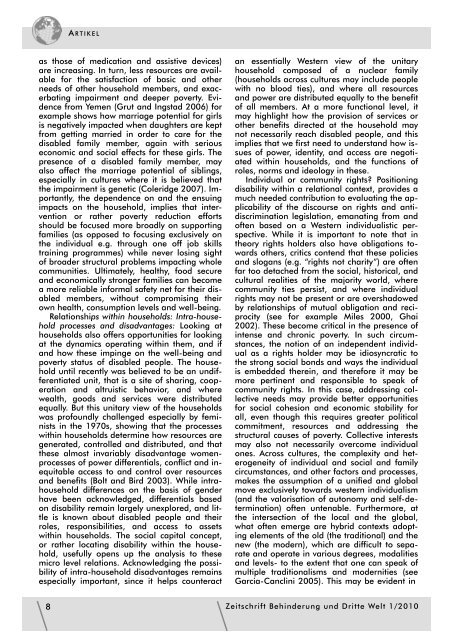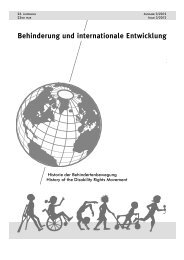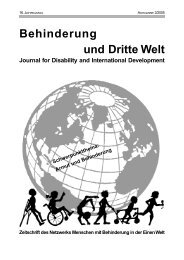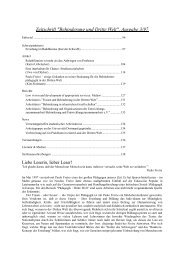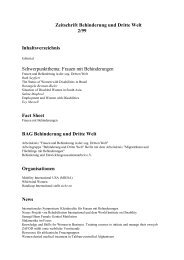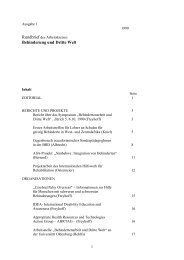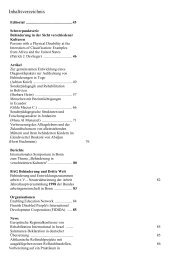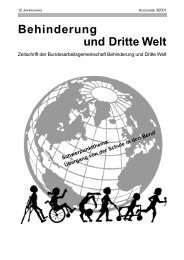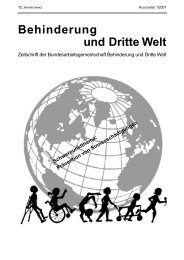Disaster and Disability in Bangladesh - Behinderung und Dritte Welt
Disaster and Disability in Bangladesh - Behinderung und Dritte Welt
Disaster and Disability in Bangladesh - Behinderung und Dritte Welt
You also want an ePaper? Increase the reach of your titles
YUMPU automatically turns print PDFs into web optimized ePapers that Google loves.
A RTIKELas those of medication <strong>and</strong> assistive devices)are <strong>in</strong>creas<strong>in</strong>g. In turn, less resources are availablefor the satisfaction of basic <strong>and</strong> otherneeds of other household members, <strong>and</strong> exacerbat<strong>in</strong>gimpairment <strong>and</strong> deeper poverty. Evidencefrom Yemen (Grut <strong>and</strong> Ingstad 2006) forexample shows how marriage potential for girlsis negatively impacted when daughters are keptfrom gett<strong>in</strong>g married <strong>in</strong> order to care for thedisabled family member, aga<strong>in</strong> with seriouseconomic <strong>and</strong> social effects for these girls. Thepresence of a disabled family member, mayalso affect the marriage potential of sibl<strong>in</strong>gs,especially <strong>in</strong> cultures where it is believed thatthe impairment is genetic (Coleridge 2007). Importantly,the dependence on <strong>and</strong> the ensu<strong>in</strong>gimpacts on the household, implies that <strong>in</strong>terventionor rather poverty reduction effortsshould be focused more broadly on support<strong>in</strong>gfamilies (as opposed to focus<strong>in</strong>g exclusively onthe <strong>in</strong>dividual e.g. through one off job skillstra<strong>in</strong><strong>in</strong>g programmes) while never los<strong>in</strong>g sightof broader structural problems impact<strong>in</strong>g wholecommunities. Ultimately, healthy, food secure<strong>and</strong> economically stronger families can becomea more reliable <strong>in</strong>formal safety net for their disabledmembers, without compromis<strong>in</strong>g theirown health, consumption levels <strong>and</strong> well-be<strong>in</strong>g.Relationships with<strong>in</strong> households: Intra-householdprocesses <strong>and</strong> disadvantages: Look<strong>in</strong>g athouseholds also offers opportunities for look<strong>in</strong>gat the dynamics operat<strong>in</strong>g with<strong>in</strong> them, <strong>and</strong> if<strong>and</strong> how these imp<strong>in</strong>ge on the well-be<strong>in</strong>g <strong>and</strong>poverty status of disabled people. The householduntil recently was believed to be an <strong>und</strong>ifferentiatedunit, that is a site of shar<strong>in</strong>g, cooperation<strong>and</strong> altruistic behavior, <strong>and</strong> wherewealth, goods <strong>and</strong> services were distributedequally. But this unitary view of the householdswas profo<strong>und</strong>ly challenged especially by fem<strong>in</strong>ists<strong>in</strong> the 1970s, show<strong>in</strong>g that the processeswith<strong>in</strong> households determ<strong>in</strong>e how resources aregenerated, controlled <strong>and</strong> distributed, <strong>and</strong> thatthese almost <strong>in</strong>variably disadvantage womenprocessesof power differentials, conflict <strong>and</strong> <strong>in</strong>equitableaccess to <strong>and</strong> control over resources<strong>and</strong> benefits (Bolt <strong>and</strong> Bird 2003). While <strong>in</strong>trahouseholddifferences on the basis of genderhave been acknowledged, differentials basedon disability rema<strong>in</strong> largely unexplored, <strong>and</strong> littleis known about disabled people <strong>and</strong> theirroles, responsibilities, <strong>and</strong> access to assetswith<strong>in</strong> households. The social capital concept,or rather locat<strong>in</strong>g disability with<strong>in</strong> the household,usefully opens up the analysis to thesemicro level relations. Acknowledg<strong>in</strong>g the possibilityof <strong>in</strong>tra-household disadvantages rema<strong>in</strong>sespecially important, s<strong>in</strong>ce it helps counteractan essentially Western view of the unitaryhousehold composed of a nuclear family(households across cultures may <strong>in</strong>clude peoplewith no blood ties), <strong>and</strong> where all resources<strong>and</strong> power are distributed equally to the benefitof all members. At a more functional level, itmay highlight how the provision of services orother benefits directed at the household maynot necessarily reach disabled people, <strong>and</strong> thisimplies that we first need to <strong>und</strong>erst<strong>and</strong> how issuesof power, identity, <strong>and</strong> access are negotiatedwith<strong>in</strong> households, <strong>and</strong> the functions ofroles, norms <strong>and</strong> ideology <strong>in</strong> these.Individual or community rights? Position<strong>in</strong>gdisability with<strong>in</strong> a relational context, provides amuch needed contribution to evaluat<strong>in</strong>g the applicabilityof the discourse on rights <strong>and</strong> antidiscrim<strong>in</strong>ationlegislation, emanat<strong>in</strong>g from <strong>and</strong>often based on a Western <strong>in</strong>dividualistic perspective.While it is important to note that <strong>in</strong>theory rights holders also have obligations towardsothers, critics contend that these policies<strong>and</strong> slogans (e.g. “rights not charity”) are oftenfar too detached from the social, historical, <strong>and</strong>cultural realities of the majority world, wherecommunity ties persist, <strong>and</strong> where <strong>in</strong>dividualrights may not be present or are overshadowedby relationships of mutual obligation <strong>and</strong> reciprocity(see for example Miles 2000, Ghai2002). These become critical <strong>in</strong> the presence of<strong>in</strong>tense <strong>and</strong> chronic poverty. In such circumstances,the notion of an <strong>in</strong>dependent <strong>in</strong>dividualas a rights holder may be idiosyncratic tothe strong social bonds <strong>and</strong> ways the <strong>in</strong>dividualis embedded there<strong>in</strong>, <strong>and</strong> therefore it may bemore pert<strong>in</strong>ent <strong>and</strong> responsible to speak ofcommunity rights. In this case, address<strong>in</strong>g collectiveneeds may provide better opportunitiesfor social cohesion <strong>and</strong> economic stability forall, even though this requires greater politicalcommitment, resources <strong>and</strong> address<strong>in</strong>g thestructural causes of poverty. Collective <strong>in</strong>terestsmay also not necessarily overcome <strong>in</strong>dividualones. Across cultures, the complexity <strong>and</strong> heterogeneityof <strong>in</strong>dividual <strong>and</strong> social <strong>and</strong> familycircumstances, <strong>and</strong> other factors <strong>and</strong> processes,makes the assumption of a unified <strong>and</strong> globalmove exclusively towards western <strong>in</strong>dividualism(<strong>and</strong> the valorisation of autonomy <strong>and</strong> self-determ<strong>in</strong>ation)often untenable. Furthermore, atthe <strong>in</strong>tersection of the local <strong>and</strong> the global,what often emerge are hybrid contexts adopt<strong>in</strong>gelements of the old (the traditional) <strong>and</strong> thenew (the modern), which are difficult to separate<strong>and</strong> operate <strong>in</strong> various degrees, modalities<strong>and</strong> levels- to the extent that one can speak ofmultiple traditionalisms <strong>and</strong> modernities (seeGarcia-Cancl<strong>in</strong>i 2005). This may be evident <strong>in</strong>8 Zeitschrift Beh<strong>in</strong>derung <strong>und</strong> <strong>Dritte</strong> <strong>Welt</strong> 1/2010


